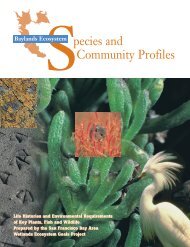Species and Community Profiles - San Francisco Estuary ...
Species and Community Profiles - San Francisco Estuary ...
Species and Community Profiles - San Francisco Estuary ...
Create successful ePaper yourself
Turn your PDF publications into a flip-book with our unique Google optimized e-Paper software.
Plants<br />
outside the influence of Sierran gold mining <strong>and</strong> prior<br />
to extensive diking, were evident in maps of the Bay prepared<br />
in the 1870s (U.S. Coast Survey maps).<br />
Marsh Sediments <strong>and</strong> Plants – Depositional environments<br />
of tidal marshes in the <strong>San</strong> <strong>Francisco</strong> <strong>Estuary</strong><br />
are variable <strong>and</strong> are significant for the distribution<br />
of uncommon plant species. In most of the <strong>San</strong> <strong>Francisco</strong><br />
<strong>Estuary</strong>, the sediments of the middle-marsh marsh<br />
plain consists of bay mud (fine silt <strong>and</strong> clay) with significant<br />
percentage of organic matter in mature marshes.<br />
Local coarse sediment deposits, often beach ridges<br />
(marsh berms, or marsh-beach ecotones) composed of<br />
s<strong>and</strong>, shell fragments, organic debris, or mixtures, create<br />
physically mobile (periodically eroded <strong>and</strong> redeposited),<br />
well-drained high marsh habitats with affinity for<br />
some common high marsh species (e.g., Grindelia stricta<br />
var. angustifolia, gumplant) <strong>and</strong> probably also species<br />
now locally extinct or rare, such as Suaeda californica,<br />
Atriplex californica (California saltbush), <strong>and</strong> Castilleja<br />
ambigua (salt marsh owl’s clover or Johny-nip). Marsh<br />
berms are associated with relatively high wave energy environments<br />
in the <strong>Estuary</strong>, located near coarse sediment<br />
sources such as eroding bluffs, submerged fossil s<strong>and</strong> <strong>and</strong><br />
shell deposits, stream mouths, <strong>and</strong> eroding marsh edges.<br />
Such features were commonly represented on U.S. Coast<br />
Survey maps of the mid-1800s, but persist today in very<br />
few localities of the <strong>Estuary</strong> (e.g., Point Pinole, Redwood<br />
City area, <strong>San</strong> Le<strong>and</strong>ro area, <strong>and</strong> northern <strong>San</strong> <strong>Francisco</strong><br />
peninsula). Similar coarse-sediment features probably occurred<br />
as natural levees of upstream reaches of large tidal<br />
sloughs with significant coarse sediment loads, as is observed<br />
today in Morro Bay. Alluvial fans also create<br />
gradually sloping ecotones with upl<strong>and</strong>s, with variably<br />
textured sediments <strong>and</strong> freshwater runoff <strong>and</strong> seeps. Few<br />
small alluvial fans exist at tidal marsh edges of the <strong>Estuary</strong><br />
today (e.g., Point Pinole, Whittell Marsh), but were<br />
historically abundant in parts of the <strong>Estuary</strong>, supporting<br />
diverse ecotonal plant communities (Cooper 1926).<br />
Analogous alluvial fan-tidal marsh ecotones occur in<br />
maritime salt marshes of Point Reyes <strong>and</strong> Tomales Bay<br />
areas, where they support distinctive local plant assemblages,<br />
including uncommon to rare species.<br />
Peter Baye<br />
Regionall rare salt marsh owl’s clover, or Johnny-nip<br />
(Castilleja ambigua ssp. ambigua). (Tidal marsh,<br />
Whittell Marsh, Point Pinole)<br />
10 Bayl<strong>and</strong>s Ecosystem <strong>Species</strong> <strong>and</strong> <strong>Community</strong> <strong>Profiles</strong><br />
Comparison With Other Estuaries – The tidal<br />
marshes of the <strong>San</strong> <strong>Francisco</strong> <strong>Estuary</strong> are the most extensive<br />
on the central coast of California, <strong>and</strong> their plant<br />
communities are distinct from other central coast tidal<br />
marshes in many respects. Most other large central coast<br />
tidal marshes are associated with shallow embayments<br />
with large open tidal inlets (e.g., Tomales Bay, Drakes<br />
Estero <strong>and</strong> Bolinas Lagoon in Marin County; Bodega<br />
Bay in Sonoma County; Elkhorn Slough in Monterey<br />
County; Morro Bay in <strong>San</strong> Luis Obispo County) which<br />
impose strong marine influence on the character of their<br />
sediments, salinities, <strong>and</strong> vegetation. Central coast tidal<br />
marshes tend to be isolated <strong>and</strong> few because of the steep<br />
modern shoreline with few valleys or wave-sheltered<br />
bays. These tidal marshes have extensive s<strong>and</strong>y substrates,<br />
relatively small, local inputs of fine sediment <strong>and</strong><br />
freshwater discharges <strong>and</strong> brackish (mesohaline) conditions,<br />
<strong>and</strong> are inundated by water approaching marine<br />
salinity (34 ppt) during most of the growing season.<br />
Some tidal marshes associated with stream mouths have<br />
relatively more freshwater influence <strong>and</strong> brackish marsh<br />
vegetation (e.g., pre-historic Elkhorn Slough <strong>and</strong> Salinas<br />
River, Monterey County; Russian River estuary,<br />
Sonoma County), but in association with seasonal reduction<br />
in tidal influence because of partial or complete closure<br />
of coastal inlets at river mouths (dammed by s<strong>and</strong><br />
beach ridges during periods of relatively low river discharge).<br />
In contrast, the tidal marsh plant communities<br />
of the <strong>San</strong> <strong>Francisco</strong> Bay <strong>Estuary</strong> developed under conditions<br />
of abundant <strong>and</strong> predominantly fine sediment<br />
(bay mud, clayey silts <strong>and</strong> silty clays with high nutrientholding<br />
capacity), relatively large tidal range, <strong>and</strong> extensive<br />
brackish marshes associated with relatively large<br />
freshwater discharges, distributed over broad, fluctuating<br />
salinity gradients (Atwater et al. 1979)<br />
Historically, salt pans (unvegetated, seasonally inundated<br />
depressions or flats within the tidal marsh) <strong>and</strong><br />
local salt ponds (perennial deposits of crystalline salt in<br />
hypersaline ponds) were well-developed in <strong>San</strong> <strong>Francisco</strong><br />
Bay tidal marshes (U.S. Coast Survey T-charts, 1850s),<br />
supporting distinctive vegetation (widgeongrass, Ruppia<br />
maritima, in some pans) or microalgal floras (in salt<br />
ponds). Pans are relatively infrequent in other central<br />
coast tidal marshes compared with the historic conditions<br />
of the <strong>San</strong> <strong>Francisco</strong> <strong>Estuary</strong>, <strong>and</strong> natural salt ponds<br />
were not known to occur in other central coast tidal<br />
marshes. Today, edges of high marsh pans are associated<br />
with at least two regionally rare species (Cordylanthus maritimus<br />
ssp. palustris <strong>and</strong> Castilleja ambigua ssp. ambigua),<br />
<strong>and</strong> may have been associated with many others in the past<br />
(e.g., Lepidium latipes, L. oxycarpum; Table 1.3)<br />
Tidal Marsh Plant Communities<br />
The distribution of tidal marsh plants is strongly (but<br />
not exclusively) influenced by tidal elevation <strong>and</strong> salin-



